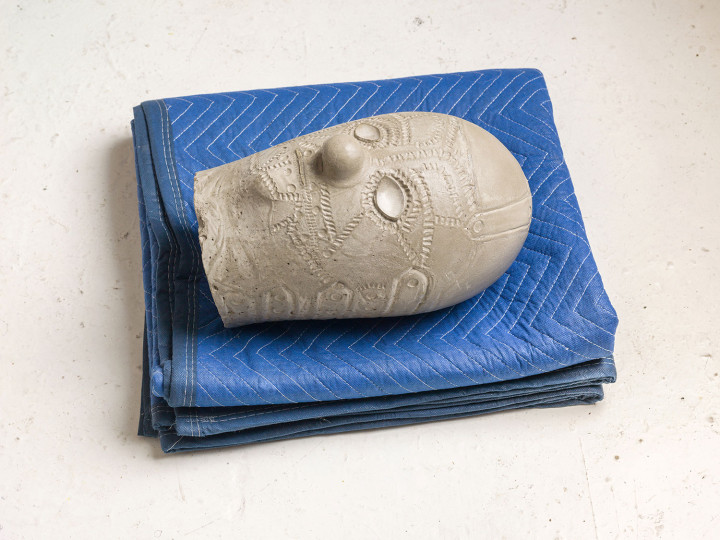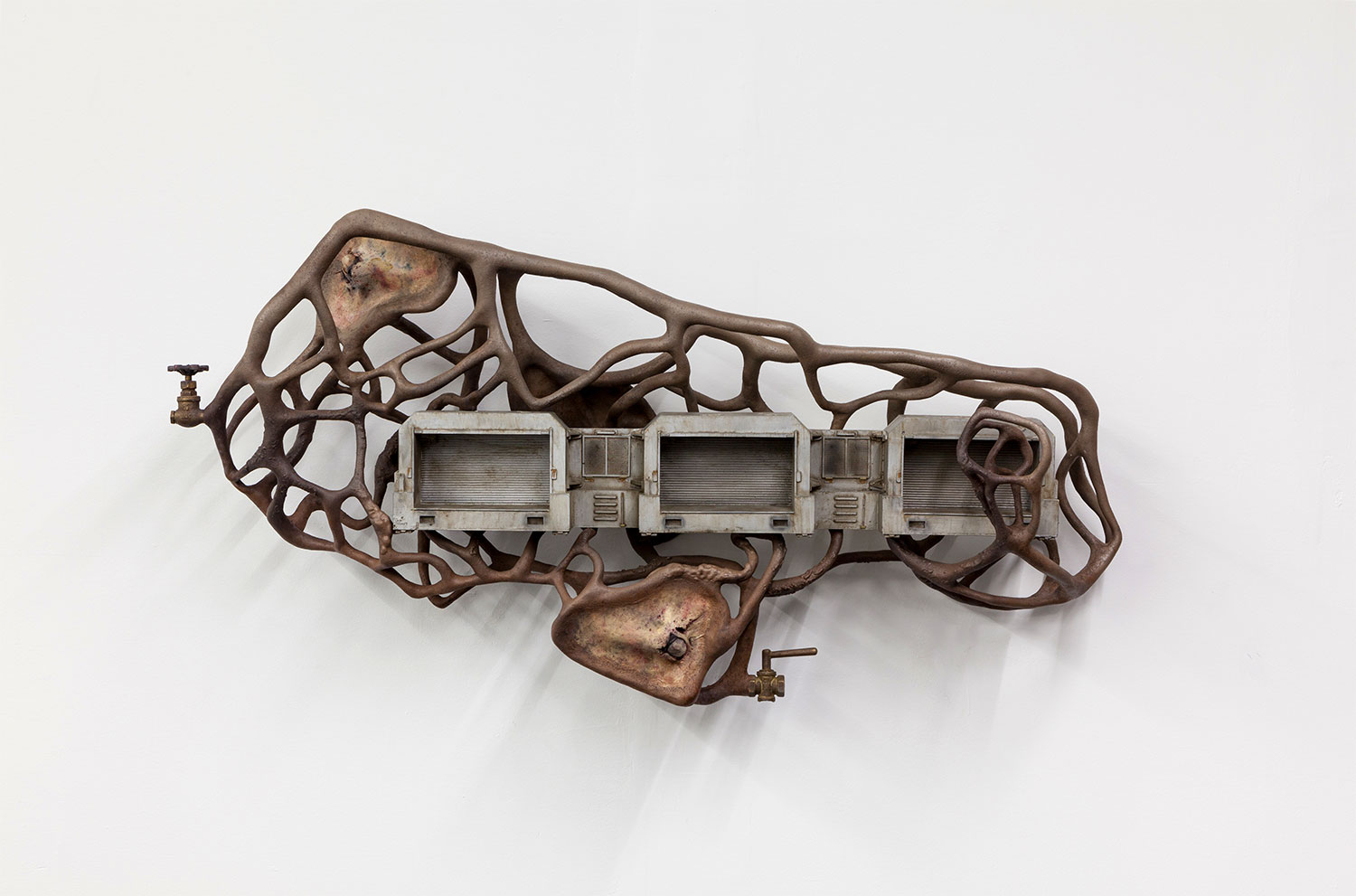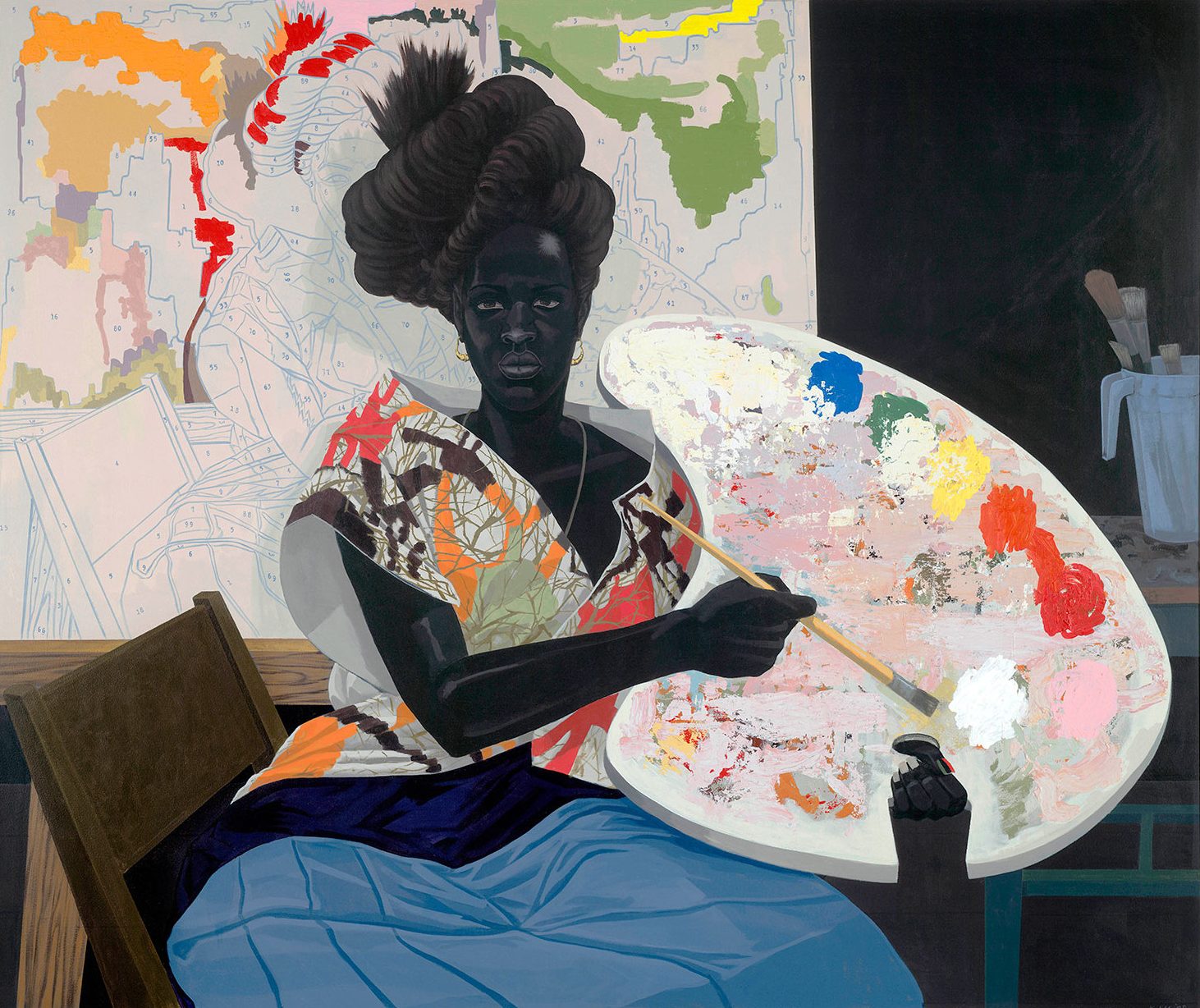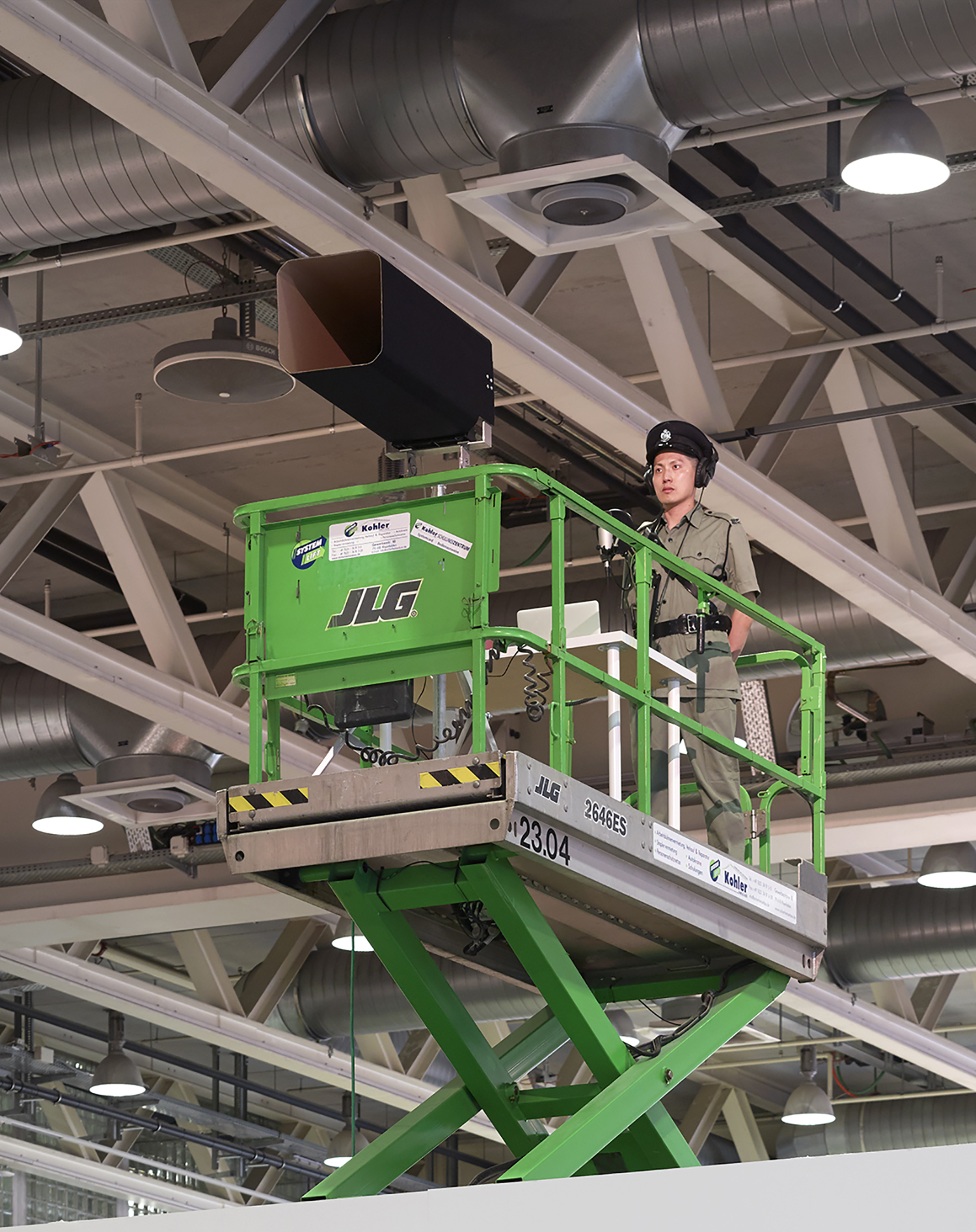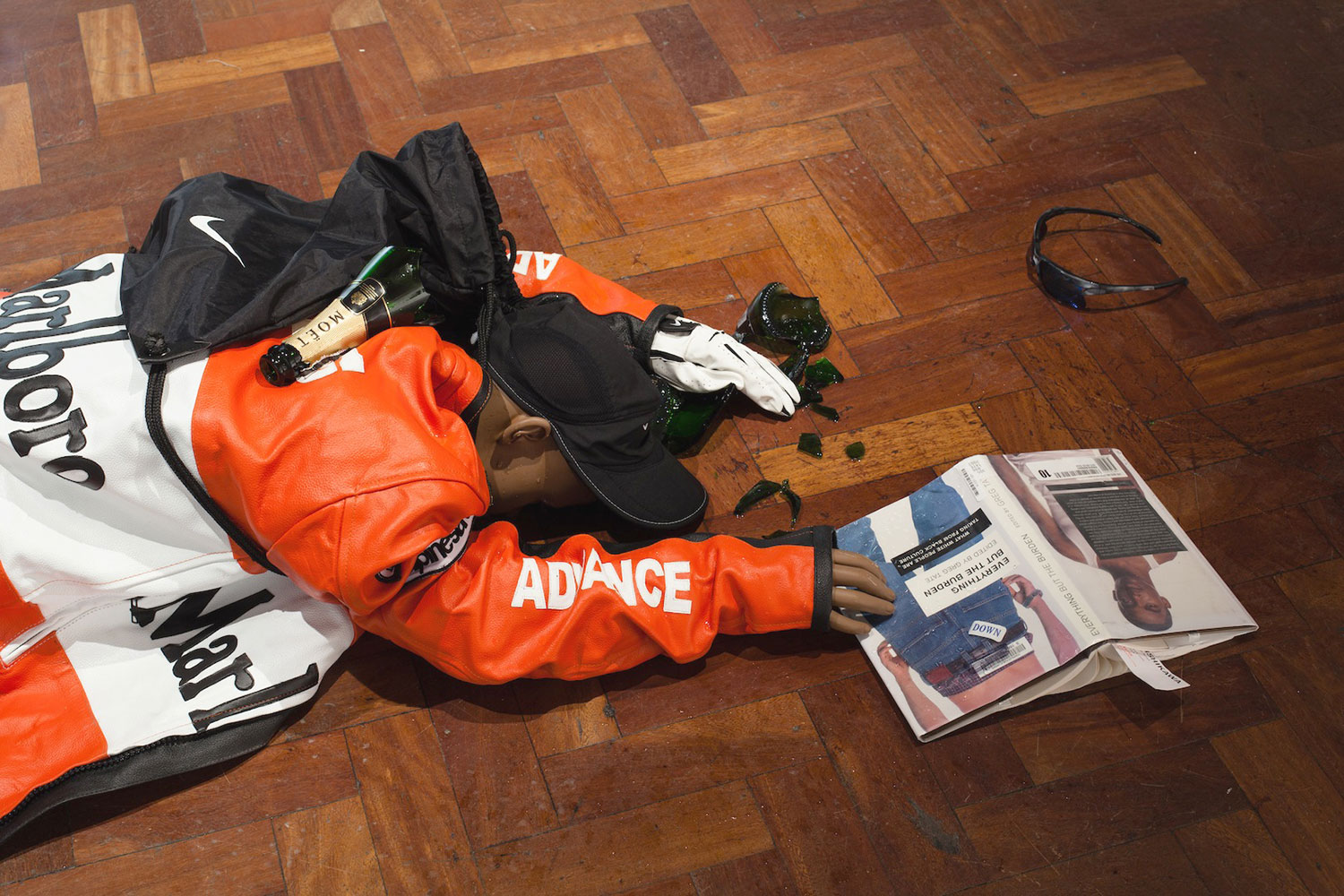
Writing about the work of the French artist Jean-Luc Moulène (b. 1955, France; lives in Paris), I’ve reached, many times, for words that describe the deep center of a thing — bone marrow, heart, central core. Beholding Moulène’s recent work involves not only looking, but attempting to reach into the innermost interior of another object, presence or material: to make an approach into the center. And in this way Moulène is an artist who allows one to think about both peculiar and important forms of empathy, one of the most critical problems of the current age. I don’t mean a kindly, gentle thought about how someone else might feel. I mean an attempt to get inside something violent or difficult or alien in the only ways that are available to you: speculation, imagination, experience, logic, some kind of Stanislavskian embodiment technique. Don’t forget that all of these strategies by which we try to understand others are rude, reckless and, by their very nature, flawed. And yet still the effort itself is deeply important in an era of confirmation bias, consensus bubbles, post-factual reportage and emotion-led politics. The structures by which we assemble ourselves politically — algorithms, social networks, clickbait media, the markets — insulate us from those with whom we might disagree. We have entered an era of polarization and fantasy with cavernous moral and political divides that can seem, at times, unbridgeable.
Certain works by Moulène offer a material realization of that problem, presenting affective voids that are genuinely unreachable. For instance, Tronches / Gardiens écorchés (Paris, May 2014) (2014): an object made by using a full-head Halloween mask as a mold in which to cast concrete. Placing my own head before this concrete one, encountering it one-to-one, I’m struck by how hermetic an object it is — a concrete, sealed-in face turned inward, impenetrable. And yet, this head and its presence works its way into my own head, because the sense-making, relation-forming part of my brain wants to compare this head to my own. I fixate on two rows of strangely protruding teeth, an imprint seemingly taken from the back of a set of teeth, and suddenly my gaze tries to convolutedly swing inward. I think about a form of vision that could be located in the center of the head and look out at the back of my teeth, instead of on their exterior, as well as other views of the body from within. That sensation, of turning oneself inside out, seems particularly relevant to the monster masks that the artist selects. For a 2014 exhibition, “Torture Concrete” at New York’s Miguel Abreu Gallery, many more of the Tronches — made from other masks including the Joker, a dragon and a flying monkey — were laid on the floor on top of blue packing blankets (it seems that a gardien écorché [tormented guard] mask is a flayed-head mask). The works seem to suggest a difficult truth regarding the nature of empathy: you cannot materially turn yourself inside out in order to consider another being without being at war with yourself and your own body.

Creating something that is clearly and immediately fighting itself, choking, gagging, spitting itself out or questioning its own status as an object, is a central part of Moulène’s stock in trade. Take what is perhaps his best-known series, Objets de grêve [Strike Objects] (1999–2000), a series of photographs documenting products made by industrial workers on strike, each depicted cleanly and objectively on a neutral background. (Moulène worked primarily in photography until the early 2000s; these images in particular seem to draw from the time he worked in advertising.) A packet of Gauloises cigarettes, for example, has been produced in red instead of its signature blue, and has the words “ocupée depuis le 23.2.82 pour le redémarrage, contre la fermeture de l’établissement” beneath the logo. A bottle of cleaning product announces that it is scented with “parfum de solidarite” and features the upturned palm of a striking hand, with the words “touche pas a mon emploi!” emblazoned across it. The back of a watch is engraved with details of a conflict from October 1974, while the base of a frying pan reads “relaxe,” encircled by the words “emploi,” “solidarité,” “liberté” and “justice.”
As fascinating as these objects are in an anthropological or historical sense, they also carry a strange form of tautology at the core of their very existence. While “not producing” the objects, workers have nonetheless produced them, and so the markers of stoppage must be conveyed by other means. A product’s relationship with its consumer is conveyed and circulated by continuing to create and distribute that product, despite the fact that the very nature of its production is in dispute. The conflict is the core of the object. Moulène took a related approach to a later series, Produits de Palestine (2002–04), photographing products made in the occupied territories of the Gaza Strip and West Bank and branded as Palestinian. Due to sanctions, the products, which advertise a form of Palestinian identity, cannot leave the place in which they are produced. Bottles of olive oil and tinned tomatoes are beautifully depicted in pairs, in the style of lush, still-life product photography, yet they represent a kind of blockage within the circulatory system, an occlusion, a strangulation.

But human bodies and territories are not the only zones of conflict that Moulène’s works form themselves around. La Vigie (The Lookout Man) (2004–11), the artist’s monumental photographic essay, is a series of images of one particular species of plant, paulownia tomentosa, sometimes called the “princess tree.” The series began when the artist noticed a plant sprouting out of the asphalt next to the Ministry of Finance. Following the progress of this tenacious sprout in the area for the following seven years, the artist created a suite of 299 images in which both artist and plant are intertwined as witnesses to a backdrop of escalating fear made physically manifest in Paris streets: anti-terrorist security measures such as bollards, fences and barricades instituted by the Vigipirate national security system. It’s a baleful irony that in the years since the series was completed, the relationship to terror in Paris and France has become ever more grim.
But what does it do to us to imagine that the plant, as much as the artist, is a kind of watcher, and to consider the world from this quiet being’s perspective at ankle-biting height? In the recently published novel Pond by Claire Louise Bennett, the protagonist describes the narrative of a half-remembered book in which the last woman alive realizes that she has become equivalent to any other type of object, for there is no species or community, just her singular body.
“For a few moments I looked away from the pages so that there was some opportunity for me to feel a little of what she must have felt when she looked at her face with the same sort of attention one brings to bear upon the bark of a tree, the surface of a rock, the skin of a peach, and in those few moments it was as if the pupils in my own eyes became tunnels and I was suddenly sucked backwards.” [Riverhead Books, 2016, p. 90]
This description of an internalized gaze that is “sucked backwards” when confronted with the possibility of viewing oneself and the world on the same register, and even intertwined with animals, objects or rocks, strikingly evokes the experience of engaging with one of Moulène’s works — for example Arthur (2010), a sculpture in which a human skull is partly encased in cast concrete, so that only the crown of the head appears. Or Tête-à-Cul (Paris, spring 2014) (2014), a hanging sculpture of a boar’s jawbone and a doe’s hipbone connected by a pale balloon that has been inflated inside them, affixed with latex. Cream bulges protrude like eyes, cheeks and other forms of bodily swellings. Somehow it is possible to treat this head-body as a complete entity with a possible spirit and character, however truncated, malformed, squeezed and inhuman that presence might be.

Allowing a flexible and viscous material to react to a more rigid structure also informs one of Moulène’s most important bodies of work, which takes knots and knottiness as a formal point of departure. The artist is avowedly interested in the mathematical study of knots and knot theory; as he told me via email “The knot can be considered like a tool for describing the behavior of complexity and chaos, even at a first glance.” In several works, a lattice-like knot structure is made with thin steel laces before a colored glass form is blown inside the structure, as though it is attempting to rupture its encasement within the tangle. Other knots, such as versions of the interlinked Borromean rings, are made entirely of loops of colored glass, such as Blown Knot 63 2, Borromean, Varia 03 (CIRVA, Marseille, 2012) (2012), in which linked and fused rings of sky blue, neon yellow and treacly orange seem to wrestle with each other around an empty center.
Returning to the question of empathy, Moulène’s knot sculptures also communicate, through material, an important commitment to complexity. “What interests me,” the artist has said, “are the functions of transformation.” [Jean-Luc Moulène in conversation with with Briony Fer, in Jean-Luc Moulène, Cologne: Verlag der Buchhandlung Walter König; Nimes: Carré d’art–Museé d’art contermporain de Nimes, 2009, p. 139.] It’s for this reason that his upcoming exhibition at Centre Pompidou, in Paris, is not a retrospective, but rather a “retrospective of protocols,” which are positions that refuse to resolve. This thinking through of the unstable, tangled position is elegantly expressed by a series of slender bronze sculptures, “Nœuds” (2010–12), which resemble hipbones, blossoms or other folded forms on stalks. These works, which also begin with knot theory, are made by making wire knots in blocks of soft clay before pulling them tight and displacing the center of the block in cleaved-away slivers. Casting the spaces that are left in bronze, the artist thereby casts the heart of a knot, a space that is impossible for us to access, which is as strong a material definition of empathy as I can imagine. “Gently, the ‘Nœuds’ have occupied my thoughts with a clear complexity that has rejuvenated my world.” The works recall certain pieces by the brilliant Polish sculptor Alina Szapocznikow, whose sculptures summon a sensual, degrading body, in all its joys and traumas. Moulène’s work, however, arrives in an altered, widened plane of existence. It doesn’t stop at the human body, but reaches toward the esoteric, the mathematical, and the flora, fauna and other objects of the planet — suggesting complex, elaborate binds with other materials and presences.

